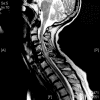Infarction of the cervical spinal cord following multilevel transforaminal epidural steroid injection: case report and review of the literature
- PMID: 17853663
- PMCID: PMC2031936
- DOI: 10.1080/10790268.2007.11753957
Infarction of the cervical spinal cord following multilevel transforaminal epidural steroid injection: case report and review of the literature
Abstract
Background/objective: Transforaminal epidural steroid injection is a widely utilized nonsurgical strategy for the management of cervical radicular and axial pain. The technique has been shown to be efficacious in relieving the patients' symptoms. Although effective, there are a range of possible complications associated with this procedure. We report the case of a patient with an acute infarction of the cervical spinal cord after a multilevel transforaminal epidural steroid injection.
Methods: We performed a retrospective chart review of a single case.
Results: The patient suffered an acute brainstem and cervical spinal cord infarction despite the use of many techniques to minimize the occurrence of vascular injury during the procedure. The patient regained some function after medical and physical therapy.
Conclusions: This complication, to our knowledge, has only been reported in the literature on 2 other occasions and serves as a reminder of the potentially devastating consequences of performing procedures in proximity to the nervous system.
Figures
Similar articles
-
Spinal cord infarction following cervical transforaminal epidural injection: a case report.Spine (Phila Pa 1976). 2005 May 15;30(10):E266-8. doi: 10.1097/01.brs.0000162401.47054.00. Spine (Phila Pa 1976). 2005. PMID: 15897816
-
Cervical epidural steroid injections and spinal cord injuries.Spine J. 2016 Oct;16(10):1163-1166. doi: 10.1016/j.spinee.2015.08.068. Epub 2015 Sep 14. Spine J. 2016. PMID: 26383496
-
Paraplegia following image-guided transforaminal lumbar spine epidural steroid injection: two case reports.Pain Med. 2009 Nov;10(8):1389-94. doi: 10.1111/j.1526-4637.2009.00728.x. Epub 2009 Oct 26. Pain Med. 2009. PMID: 19863744
-
Cervical Epidural Steroid Injection: Techniques and Evidence.Phys Med Rehabil Clin N Am. 2018 Feb;29(1):1-17. doi: 10.1016/j.pmr.2017.08.001. Epub 2017 Oct 16. Phys Med Rehabil Clin N Am. 2018. PMID: 29173656 Review.
-
Stroke following epidural injections--case report and review of literature.J Neuroimaging. 2013 Jan;23(1):118-21. doi: 10.1111/j.1552-6569.2011.00615.x. Epub 2011 Jun 23. J Neuroimaging. 2013. PMID: 21699610 Review.
Cited by
-
Cervical epidural steroid injections for the treatment of cervical spinal (neck) pain.Curr Pain Headache Rep. 2013 Feb;17(2):314. doi: 10.1007/s11916-012-0314-7. Curr Pain Headache Rep. 2013. PMID: 23315021 Review.
-
Complex regional pain syndrome type II after cervical transforaminal epidural injection: A case report.Medicine (Baltimore). 2018 May;97(20):e10784. doi: 10.1097/MD.0000000000010784. Medicine (Baltimore). 2018. PMID: 29768371 Free PMC article.
-
Diagnosis and Treatment of Cervical Spondylotic Radiculopathy Using Selective Nerve Root Block (SNRB): Where are We Now?Pain Ther. 2022 Jun;11(2):341-357. doi: 10.1007/s40122-022-00357-1. Epub 2022 Feb 15. Pain Ther. 2022. PMID: 35167060 Free PMC article. Review.
-
Cervical transforaminal epidural steroid injection for the management of cervical radiculopathy: a comparative study of particulate versus non-particulate steroids.Skeletal Radiol. 2009 Nov;38(11):1077-82. doi: 10.1007/s00256-009-0735-5. Epub 2009 Jun 20. Skeletal Radiol. 2009. PMID: 19543892 Clinical Trial.
-
Cervical Myelopathy Caused by Injections into the Neck.Neurohospitalist. 2015 Oct;5(4):212-6. doi: 10.1177/1941874414557080. Neurohospitalist. 2015. PMID: 26425248 Free PMC article.
References
-
- Bush K, Hillier S. Outcome of cervical radiculopathy treated with periradicular/epidural corticosteroid injections: a prospective study with independent clinical review. Eur Spine J. 1996;5:319–325. - PubMed
-
- Slipman CW, Lipetz JS, Jackson HB, Rogers DP, Vresilovic EJ. Therapeutic selective nerve root block in the nonsurgical treatment of atraumatic cervical spondylotic radicular pain: a retrospective analysis with independent clinical review. Arch Phys Med Rehabil. 2000;81:741–746. - PubMed
-
- Molloy RE, Benzon HT. Interlaminar epidural steroid injections for lumbosacral radiculopathy. In: Benzon HT, Raja SN, Molloy RE, Liu SS, Fishman SM, editors. Essentials of Pain Medicine and Regional Anesthesia. Philadelphia, PA: Elsevier Churchill Livingstone; 2005. pp. 331–340. eds:
-
- Benzon HT. Selective nerve root blocks and transforaminal epidural steroid injections for back pain and sciatica. In: Benzon HT, Raja SN, Molloy RE, Liu SS, Fishman SM, editors. Essentials of Pain Medicine and Regional Anesthesia. Philadelphia, PA: Elsevier Churchill Livingstone; 2005. pp. 341–347.
-
- Brouwers PJ, Kottink EJ, Simon MA, Prevo RL. A cervical anterior spinal artery syndrome after diagnostic blockade of the right C6-nerve root. Pain. 2001;91:397–399. - PubMed
Publication types
MeSH terms
Substances
LinkOut - more resources
Full Text Sources
Medical

